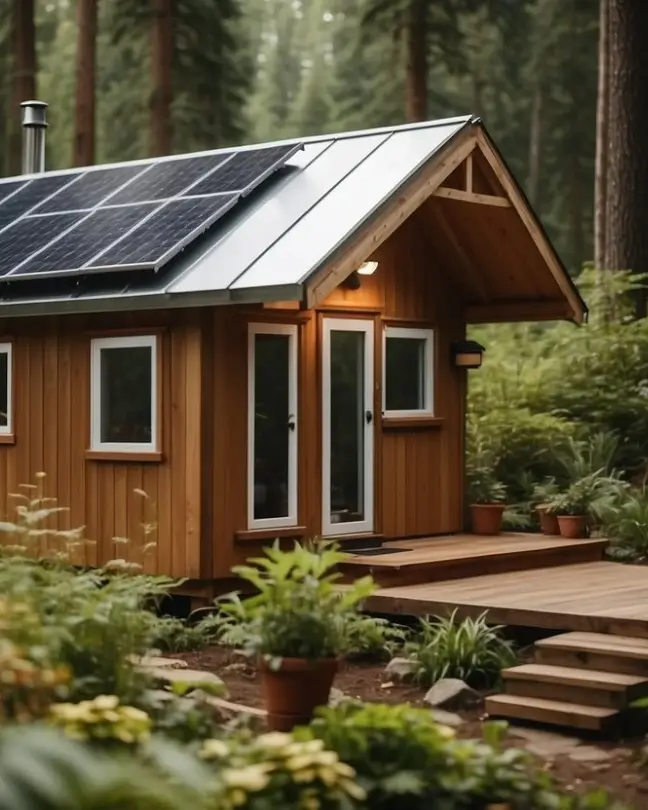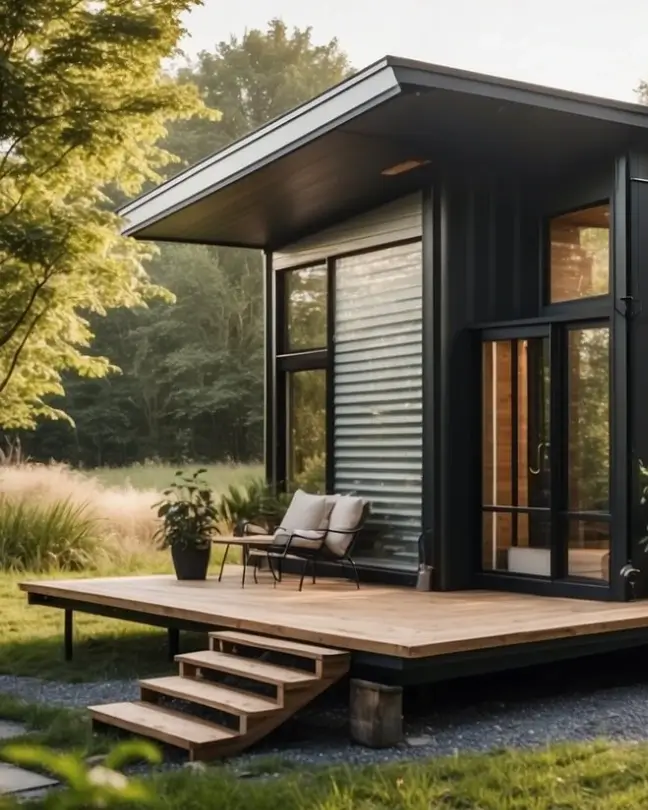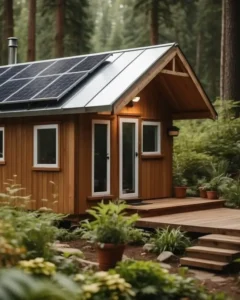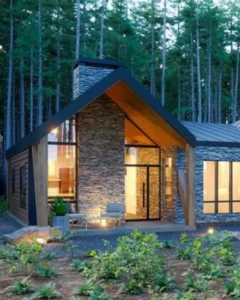If you are here only for the inspirations you can get there directly here!
Understanding Eco Tiny House

Eco tiny houses are a form of small-scale living that emphasize sustainability and minimal environmental impact. Traditionally, tiny houses range in size from about 100 to 400 square feet, significantly smaller than the average American home.
Benefits of Eco Tiny Houses:
- Energy Efficiency: They require less energy to power because of their size, which translates to lower utility bills and a smaller carbon footprint.
- Material Use: The construction of tiny homes typically involves fewer materials, lessening the ecological impact.
A tiny house’s sustainability is not just in its size, but also in its design and functioning. Smart design choices, such as maximizing natural light and space-saving features, vastly improve the home’s efficiency.
Key Features of Sustainable Tiny House Design:
- Use of renewable energy sources like solar panels.
- Installation of low-flow fixtures to reduce water usage.
- Incorporation of high-quality insulation to maintain temperature.
Choosing to live in a tiny home can represent a commitment to a lower-impact lifestyle. The reduced space encourages a minimalist lifestyle, with less consumption and waste. It’s not only about the house itself but the lifestyle that comes with it.
For those considering an eco tiny home, it’s important to remember that each aspect, from material selection to energy consumption, contributes to the home’s overall sustainability. For instance, the incorporation of low-flow showerheads can significantly reduce water consumption, while smart design ensures efficient use of space and resources.
Design Principles of Eco Tiny Houses

Eco tiny houses embody thoughtful design to achieve a minimal environmental footprint while providing a comfortable and sustainable living space. They focus on efficient use of space, choice of materials, energy conservation, and water usage reduction.
Maximizing Space Efficiency
In eco tiny houses, every inch counts. Designers optimize space by creating multi-functional areas and furniture that can be converted as needed. Clever storage solutions are integrated into staircases, under floors, and in built-in furniture to make living in a small footprint highly efficient.
Sustainable Materials Selection
Builders often use sustainably sourced or recycled materials to decrease the environmental impact. They may incorporate bamboo flooring, reclaimed wood, or recycled metal siding. These materials are not only eco-friendly but also add to the aesthetic appeal of the house.
Energy Efficiency and Renewables
Eco tiny homes typically feature high levels of insulation and energy-efficient appliances to reduce the need for heating and cooling. Many also harness renewable energy sources such as solar panels for electricity and passive solar design to take advantage of natural light and heat.
Water Conservation Features
Water-saving features are critical in eco tiny homes. They often include low-flow fixtures to minimize water usage. Systems for rainwater collection and greywater recycling are also common, allowing for irrigation or toilet flushing, thereby further conserving this vital resource.
Construction of Eco Tiny Houses
The eco-friendly construction of tiny houses involves careful planning and the use of sustainable practices. From the initial site work to the final touches, the process aims to minimize environmental impact.
Site Selection and Preparation
Choosing the right site for an eco tiny house is critical for both the environmental footprint and the structure’s efficiency. Builders should look for locations that have access to natural light and are well-drained to reduce the need for artificial lighting and large-scale excavation. They are often guided by principles that respect the existing landscape to avoid disrupting local ecosystems.
Building Techniques for Sustainability
Sustainable building techniques are at the core of eco tiny house construction. Builders opt for durable, high-performing materials that are renewable or recycled. The design should aim for functionality and adaptability to limit waste. Incorporating features like rainwater collection systems and solar panels can further enhance sustainability.
Insulation and Ventilation Strategies
Proper insulation and ventilation are fundamental for an eco tiny house to be energy efficient. Insulation options should be selected based on their environmental impact and thermal performance. Ventilation is equally important, using strategies like passive air flow and heat-recovery ventilators to maintain air quality and reduce the need for mechanical heating and cooling systems.
Emerging Trends in Eco Tiny Housing
As environmental awareness increases, eco tiny homes are evolving with new design strategies and technologies. Here’s a look at the latest trends shaping this movement.
Multi-Functional Spaces: Every inch counts in tiny homes. Designers are increasingly focusing on creating multi-functional furniture solutions that maximize usability without compromising on style or comfort.
Sustainability First: The core of eco tiny housing lies in sustainable living. The use of recycled materials, solar panels, and composting toilets are among the popular features that reduce a home’s carbon footprint.
Energy Efficiency: Smaller spaces are naturally more energy-efficient, but new eco tiny houses are being designed to optimize energy use even further, often incorporating advanced insulation techniques and smart systems for heating and cooling.
Off-grid Living: With the advent of better solar technology and water filtration systems, eco tiny homes are increasingly designed for off-grid living, enabling homeowners to live sustainably and autonomously.
Biophilic Design: Connecting with nature is a driving force in the eco tiny house movement. Incorporating living plants, natural light, and ventilation promotes wellbeing and reduces the need for artificial lighting and climate control.
By considering these trends, individuals are finding innovative ways to reduce their ecological footprints while enjoying a minimalist, yet comfortable lifestyle.
Inspirations












If you prefer to get inspiration from a video, I recommend this one:
What is eco-friendly in a house?
Eco-friendly features in a house include energy-efficient appliances, solar panels, sustainable materials, proper insulation, and water conservation systems.
How do you design an eco-friendly house?
Design an eco-friendly house by incorporating passive solar design, using sustainable building materials, ensuring excellent insulation, and installing energy-efficient systems for heating, cooling, and lighting.
What is the most eco-friendly house shape?
The most eco-friendly house shape is compact and simple, like a cube or sphere, to minimize surface area and reduce heat loss, thus improving energy efficiency.
If you liked this blog article about the topic “Eco Tiny House”, don’t forget to leave us a comment down below to tell us about your experience.
Not enough inspiration yet?
Feel free to also check out our other Articles from the category “Tiny House“ and don’t forget to follow us on Pinterest.



